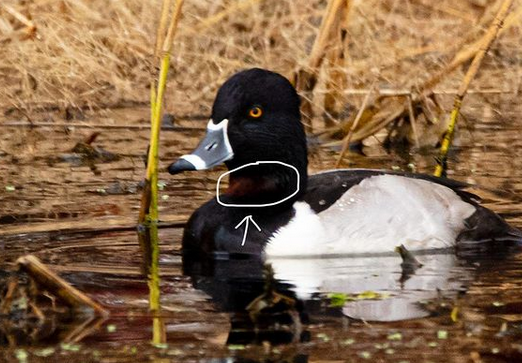This is a gorgeous bird with a somewhat confusing name, the Ring-necked Duck!

I photographed this one last week at Pungo Lake in eastern N.C.
The adult male has a glossy purple, blue and green-ish colored black head, a black back, with well-defined gray sides and a white stripe of plumage between the sides and the breast.
Their bills are a light gray with a white ring and a black tip.
Their namesake cinnamon-colored neck ring is usually not visible but occasionally you can see it if the lighting is just right!
Check out the photo below to see that sneaky ring for yourself 😉

These good looking birds breed in small areas of Alaska, across central and eastern Canada, south throughout the northern United States and into northern California and Colorado.
They spend the winter along the Pacific and Atlantic Coasts and and across the southern U.S. all the way down south into Mexico, Central America, and even the the Caribbean.
Lucky for us, Ring-neck’s are among North Carolina’s most commonly found diving ducks during the winter months from the mountains to the coast.
You can see Ring-necked Ducks here from mid to late October to late March and early April throughout the state.
Look for them foraging for a meal in large ponds and wide lakes, with forested shorelines.
Interestingly, they usually forgo inhabiting the deeper middle portions of large lakes and open waters, preferring to find a meal much closer to the shoreline.
This makes them a bit easier to see and photograph than other species of other diving ducks, something I am immensely grateful for!
Photos by @sally_siko of @birdwatching_nc on the fabulous full frame @canonusa
#5Ds





